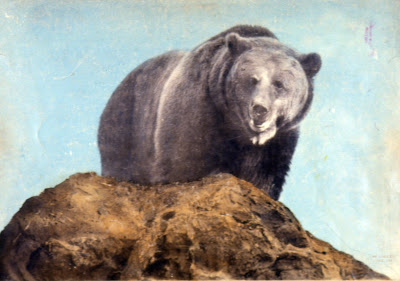The ScholarWorks unit, in conjunction with Special Collections and Archives (SCA), has created a display showcasing many different types of Boise State scholarly outputs.
Both ScholarWorks and SCA are concerned with curating the scholarship of Boise State University, as such many of the collections presented have a physical component that is housed within archives and displayed alongside the more digital quality of ScholarWorks content.
The exhibit includes information about Boise State’s first e-Journal BOGA Basque Studies Consortium Journal, which just released its 4th issue. Several articles in BOGA discuss materials in the SCA collection, such as the Nor-Nun book which is also on display. Cabinets and windows feature books and other series written or produced by Boise State, which SCA collects and many are available to read online from the ScholarWorks website.
The purely digital nature of ScholarWorks presented a distinct challenge to create a physical display, which required collaboration with SCA and Library IT. Jim Duran, Cheryl Oestreicher, and Gwyn Hervochon from SCA helped find materials which would complement each window display, as well as provided tips to arrange and present the objects and information. Bill English from Library IT creatively found ways to incorporate digital components in the exhibit.
 The unique aspect of this display is it is interactive with iPads and headphones provided to allow visitors to listen to the Idaho LGBTQ Oral History Project. Additional iPads are available for visitors to browse the ScholarWorks website to learn more about the collections on display. The library IT department also used Raspberry Pis to run a slideshow of art images on a 32” monitor.
The unique aspect of this display is it is interactive with iPads and headphones provided to allow visitors to listen to the Idaho LGBTQ Oral History Project. Additional iPads are available for visitors to browse the ScholarWorks website to learn more about the collections on display. The library IT department also used Raspberry Pis to run a slideshow of art images on a 32” monitor.
The items selected for this display were chosen to showcase the wide variety of research from not only faculty and staff, but also students (undergraduate, graduate, and post-graduate levels), and sometimes even the Boise community in relation to Boise State. Since 2009, ScholarWorks has been working to make Boise State’s scholarship openly accessible.
The largest collection is faculty publications and all of the collections combined have been downloaded over 1.5 million times from people all over the world. We hope this display helps provide you the viewer with more context as to what ScholarWorks is, does, and provides.
You can visit the display on the second floor of Albertsons Library anytime the library is open during the Spring 2016 semester, and checkout ScholarWorks online at scholarworks.boisestate.edu. We are also happy to answer any questions you may have in person (Library 217), on the phone (208-426-2581), or through email (scholarworks@boisestate.edu).
Kimberly Holling and Amber Sherman
Both ScholarWorks and SCA are concerned with curating the scholarship of Boise State University, as such many of the collections presented have a physical component that is housed within archives and displayed alongside the more digital quality of ScholarWorks content.
The exhibit includes information about Boise State’s first e-Journal BOGA Basque Studies Consortium Journal, which just released its 4th issue. Several articles in BOGA discuss materials in the SCA collection, such as the Nor-Nun book which is also on display. Cabinets and windows feature books and other series written or produced by Boise State, which SCA collects and many are available to read online from the ScholarWorks website.
The purely digital nature of ScholarWorks presented a distinct challenge to create a physical display, which required collaboration with SCA and Library IT. Jim Duran, Cheryl Oestreicher, and Gwyn Hervochon from SCA helped find materials which would complement each window display, as well as provided tips to arrange and present the objects and information. Bill English from Library IT creatively found ways to incorporate digital components in the exhibit.
 The unique aspect of this display is it is interactive with iPads and headphones provided to allow visitors to listen to the Idaho LGBTQ Oral History Project. Additional iPads are available for visitors to browse the ScholarWorks website to learn more about the collections on display. The library IT department also used Raspberry Pis to run a slideshow of art images on a 32” monitor.
The unique aspect of this display is it is interactive with iPads and headphones provided to allow visitors to listen to the Idaho LGBTQ Oral History Project. Additional iPads are available for visitors to browse the ScholarWorks website to learn more about the collections on display. The library IT department also used Raspberry Pis to run a slideshow of art images on a 32” monitor.The items selected for this display were chosen to showcase the wide variety of research from not only faculty and staff, but also students (undergraduate, graduate, and post-graduate levels), and sometimes even the Boise community in relation to Boise State. Since 2009, ScholarWorks has been working to make Boise State’s scholarship openly accessible.
The largest collection is faculty publications and all of the collections combined have been downloaded over 1.5 million times from people all over the world. We hope this display helps provide you the viewer with more context as to what ScholarWorks is, does, and provides.
You can visit the display on the second floor of Albertsons Library anytime the library is open during the Spring 2016 semester, and checkout ScholarWorks online at scholarworks.boisestate.edu. We are also happy to answer any questions you may have in person (Library 217), on the phone (208-426-2581), or through email (scholarworks@boisestate.edu).
Kimberly Holling and Amber Sherman

















